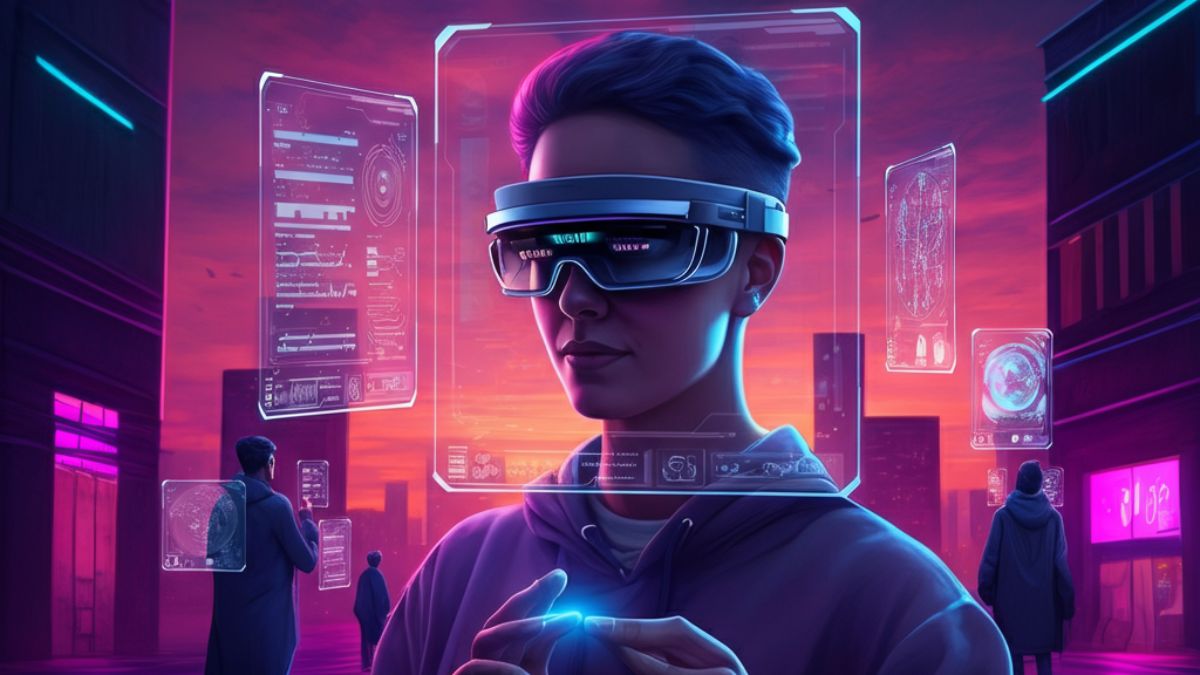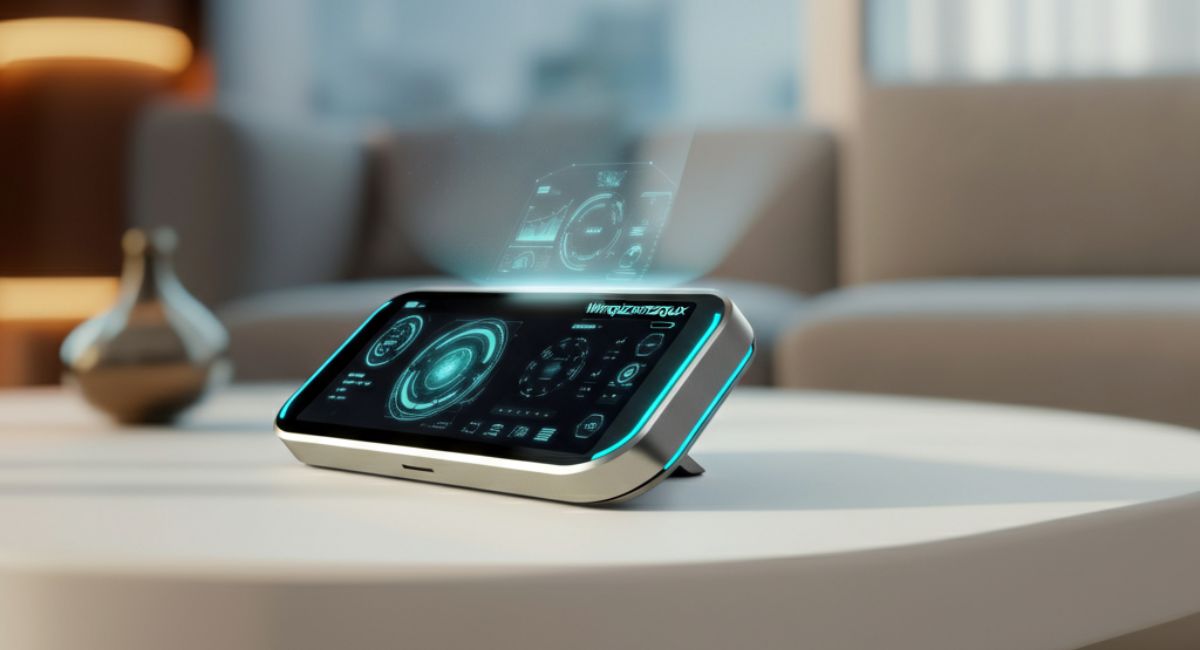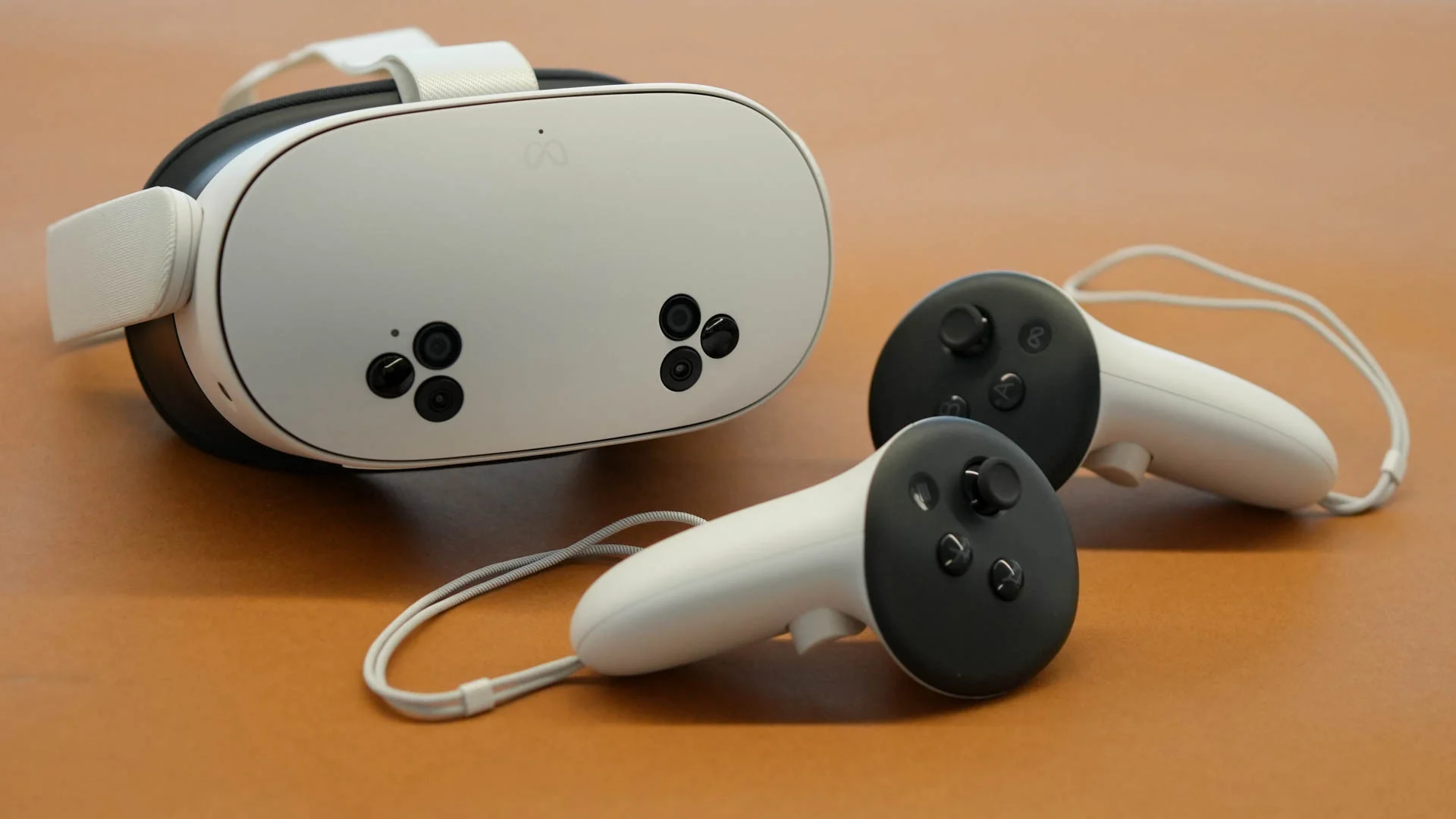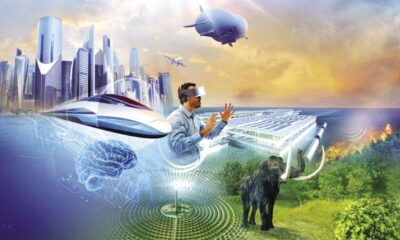TECH
Augmented Reality: Transforming How We See and Interact with the World

Augmented reality (AR) is no longer confined to the realm of science fiction or niche gaming apps. It’s here, and it’s changing everything—from how we shop to how we learn and even how we collaborate at work. But what exactly is augmented reality? How does it work, and where is it taking us next? This blog dives into the growing influence of AR and its potential in revolutionizing our everyday lives.
Whether you’re a curious tech enthusiast, an industry leader exploring new opportunities, or simply wondering why your smartphone keeps asking if you want to “try it in AR,” this guide will help you make sense of it all.
What Is Augmented Reality?
At its core, augmented reality overlays digital information, such as images, text, or sound, onto the real world in real-time through digital devices like smartphones, tablets, AR headsets, or smart glasses. Unlike virtual reality (VR), which immerses users in an entirely digital world, AR enhances the world around us by blending the physical with the digital.
You’ve likely experienced AR before without even realizing it. Remember the viral mobile game Pokémon GO? Or Instagram filters that place sunglasses on your face in real-time? Those are just simple examples of augmented reality in action.
AR combines three key components:
- Specialized Hardware: Devices with cameras and display mechanisms (smartphones, AR glasses).
- Advanced Software Algorithms: These map the environment and render AR graphics.
- Real-Time Interaction: AR responds and adjusts to your motion and surroundings seamlessly.
The Real-Life Applications of AR
Augmented reality is no longer just a cool feature in games or filters; it’s driving innovation across multiple industries. Here are some of its most exciting applications:
Shopping and Retail Experience
Online shopping used to be dominated by words and static images. Now, AR is taking it a step further. Imagine being able to place a piece of furniture in your living room through your phone before you even buy it. Ikea’s AR app does exactly that.
Beauty brands have also latched onto AR-powered virtual try-ons. Sephora’s Virtual Artist app lets you see how lipsticks or eyeshadows look on your face without needing samples. This technology has proven to reduce the barriers to purchase and increase customer confidence.
Education and Training
Who said learning has to be dry? AR is making classrooms and training sessions more engaging. For instance:
- Medical students can use AR to explore detailed 3D models of human organs.
- Schools are introducing AR apps that transform books and worksheets into interactive learning experiences.
- Professional training benefits greatly as augmented simulations prepare pilots, surgeons, and mechanics with high-stakes realism.
Healthcare
The healthcare sector stands to gain tremendously from AR:
- Surgeons use AR to visualize a patient’s internal anatomy before making incisions, enhancing precision and reducing risks.
- Apps such as AccuVein allow doctors to easily locate veins for injections or IV placement.
- Therapy and rehabilitation are further enriched, especially in cases like stroke recovery, where AR can guide patients in performing exercises correctly.
Workplace Collaboration
Augmented reality is the ultimate productivity booster for collaborative, remote, or on-site tasks:
- Microsoft HoloLens empowers engineers and architects to design and visualize prototypes as holograms before physical production.
- Teams can now work together virtually in the same “space.” AR-based apps enable users to annotate documents, share designs, or troubleshoot issues remotely as if they were there in person.
- Retailers use AR for supply chain optimization and quality control.
Entertainment and Gaming
No discussion of AR is complete without addressing its impact on entertainment:
- Mobile games, such as Pokémon GO and AR Dragon, opened up new avenues for developers to merge gameplay with the real world.
- Livestreaming and sports broadcasting now include AR overlays that bring real-time stats and visual effects to your screen.
- Museums and art galleries are using AR to provide immersive storytelling and enhanced visitor experiences.
Real Estate and Interior Design
Before stepping into a house or apartment, prospective buyers can now take AR-assisted virtual tours or overlay interior design elements in real spaces. Tools like Matterport revolutionize the real estate process by providing 3D visual mapping combined with AR integration.
Why AR is Gaining Momentum Now
Why is augmented reality blowing up right now and not, say, five years ago? The answer lies in technological advancements. A combination of increased smartphone power, 5G connectivity, and low-cost AR development kits (such as Apple’s ARKit and Google’s ARCore) has made AR more accessible than ever before.
Here are some additional factors fueling AR’s rise:
- Improved Hardware: AR-compatible devices, from smartphones to cutting-edge AR glasses, have become affordable and powerful.
- Better Content Creation: Developers can now create photorealistic AR experiences with platforms like Unreal Engine or Unity.
- Consumer Demand: The more AR products and features people experience, the more they expect them to become part of their daily lives.
Challenges in AR Development
Of course, it’s not all smooth sailing. Despite its promise, AR development faces a few hurdles:
- High Development Costs: Creating sophisticated AR experiences isn’t cheap.
- Device Dependency: AR requires hardware with cameras and processors powerful enough to handle intense algorithms.
- User Experience Issues: If AR apps lag or glitch, they can be frustrating.
- Privacy Concerns: Real-time interaction with surroundings means AR apps collect massive amounts of data, raising privacy questions.
Developers are working around these challenges, and as AR matures, its potential will grow even further.
The Future of Augmented Reality
What can we expect from AR in the years to come? Experts predict the technology will go beyond entertainment and shift into shaping our everyday lives. Imagine:
- Using AR glasses to receive real-time GPS guidance without looking at your phone.
- Medical professionals performing surgeries remotely using AR-assisted robots.
- Entire classrooms being transformed into immersive historical or scientific landscapes.
With major tech giants such as Apple, Google, and Meta investing billions into AR, the pace of innovation will only accelerate. Soon, the line between physical and digital reality may blur altogether.
How AR is Transforming Business Opportunities
Businesses adopting AR early stand to gain a competitive edge. Whether you’re in retail, education, healthcare, or entertainment, AR creates opportunities to engage audiences and improve services like never before:
- Boosting Brand Loyalty: Offering AR experiences builds stronger emotional connections with customers.
- Streamlining Operations: AR innovations can minimize costs and increase efficiency.
- Driving Revenue: By providing an interactive experience, AR-supported businesses see higher conversion rates.
How You Can Get Started with AR
Curious to explore augmented reality for your business or personal projects? Start by:
- Researching AR development tools like ARKit and ARCore.
- Experimenting with AR functionality in apps you already use.
- Consulting AR solution providers to assess how it can fit your business needs.
Act Now, Stay Ahead of the Curve
Whether it’s helping customers “try before they buy,” offering immersive retail experiences, or unlocking educational potential, AR is a technology no business—or individual—can afford to ignore. It’s not a trend; it’s a transformation.
Bridging AR and AI
One of the most exciting developments in technology today is the intersection of augmented reality (AR) and artificial intelligence (AI). When combined, these two technologies create smarter, more adaptive experiences that are changing the way we interact with digital content. AI enhances AR environments by providing context-aware responses, enabling features such as object recognition, natural language processing, and predictive suggestions.
For example, AI-powered AR applications in retail can not only allow customers to visualize products in their home but also analyze preferences and recommend complementary items. Similarly, in healthcare, AR and AI together can support real-time diagnostics by identifying abnormalities in medical scans or offering procedural guidance during surgeries.
This fusion of technologies is paving the way for a more intelligent, responsive, and personalized digital future, solidifying AR’s role as a catalyst for innovation across industries.
AR in Education and Training
The educational landscape is being revolutionized by augmented reality, creating opportunities for deeper engagement and practical learning. AR applications offer immersive experiences that bring lessons to life, whether it’s exploring the human body in 3D, walking through historical landmarks, or conducting virtual science experiments. These tools enhance comprehension and retention by making abstract concepts tangible and visually compelling.
AR is also a powerful tool in professional training. Industries such as aviation, manufacturing, and healthcare leverage AR to simulate complex environments or tasks, allowing trainees to practice in safe, controlled settings. For instance, pilots use AR-assisted simulations to prepare for real-world scenarios, while medical students can perform virtual surgeries with precision and guidance. By combining theoretical knowledge with hands-on practice, AR equips learners with the confidence and skills they need to excel.
The potential for AR in education and training is limitless, laying the foundation for a more practical, engaging, and accessible learning experience across all ages and professions.
TECH
Designing the Perfect Website for Clingr Users

Creating a Digital Home That Engages and Converts
Your website is the digital storefront of your business. For Clingr, a platform designed to bring people closer, having an engaging, user-friendly website is essential to attract and retain users. Whether you’re looking to foster deep friendships or meaningful networks, your website should reflect the values and functionality that Clingr stands for.
This blog will guide you through key principles and strategies for designing the perfect website for Clingr users. From user experience (UX) design to creating visually captivating aesthetics, we’ll explore the elements that contribute to a successful, functional, and conversion-driven website.
Why Website Design Matters
Your website often forms the first impression of your platform. Consider these statistics:
- 75% of users judge a company’s credibility based on its website design.
- If your site takes over 3 seconds to load, 53% of mobile visitors will leave immediately.
For Clingr, a platform that thrives on relationships, a poorly designed website can drive users away before they even sign up! Our goal is to develop a site that embodies your mission of connection and fosters immediate trust.
Guiding Principles for Clingr Website Design
1. Prioritize User-Focused Design
A user-centric design is the backbone of any successful website. For Clingr, you must cater to two types of users:
- The Curious Visitor: Someone exploring your platform for the first time.
- The Active Community Member: Someone already invested in Clingr’s offerings.
Tips to Execute User-Focused Design:
- Intuitive Navigation: Use a clean and straightforward menu that guides users effortlessly. Avoid overwhelming them with too many options.
- Clear Calls-to-Action (CTAs): Buttons like “Sign Up,” “Join Now,” or “Start Connecting” should be prominent and visually appealing. Make users’ next steps feel obvious.
- Personalization: Offer tailored content and suggestions for returning users. For example, recommend groups or communities they might be interested in.
2. Prioritize Speed and Accessibility
Speed and accessibility are essential elements of any modern website. Clingr users expect your website to load fast and be accessible across various devices and browsers.
Best Practices for Speed Optimization:
- Optimize images and graphics for faster load times. Striking imagery is fantastic but shouldn’t compromise speed.
- Minimize JavaScript and CSS files through compression. This reduces file size and enhances site performance.
Accessibility Considerations:
- Ensure compatibility with screen readers.
- Use alt text for all images to cater to visually impaired users.
- Maintain high color contrast to improve readability for all users.
3. Striking the Right Visual Tone
Clingr is all about connection, togetherness, and forming relationships. Your website should embody this ethos visually.
Style and Branding Tips:
- Color Palette: Choose warmer, inviting tones such as blues (trust), greens (growth), and oranges (energy).
- Imagery: Integrate images of people interacting authentically to represent real-world connections.
- Typography: Use modern, clean fonts for readability and professionalism. Ensure consistency across all branding materials.
4. Create Value Through Content
To retain user interest, your website must offer tangible value. Educational content, news updates, and posts from active community members can demonstrate the value of being part of Clingr.
Types of Content to Feature:
- Community Stories: Highlight authentic success stories of individuals or groups who formed meaningful connections via Clingr.
- Expert Blogs: Publish advisory blogs or articles. For example, “How to Build Better Connections Online” or “5 Ways to Build Trust in Digital Communities.”
- FAQs: Address common questions succinctly to help users quickly grasp Clingr’s purpose and functionality.
5. Incorporate Strong Social Proof
Trust is critical in platforms like Clingr, and showcasing user satisfaction is invaluable in building credibility.
How to Feature Social Proof:
- Testimonials: Use real, heartfelt stories from users praising Clingr for its positive impact.
- Statistics (“98% of users said they formed meaningful relationships”): Present credible data points that demonstrate success.
- Media Mentions or Reviews: Have you been praised by notable bloggers or publications? Display those shoutouts prominently.
6. Leverage Artificial Intelligence and Chatbots
Ensure that your visitors always feel guided or assisted, even when you’re offline. AI-integrated chatbots can provide users with real-time answers and help them get started quickly.
Functional Uses of AI for Clingr:
- Welcome new visitors by guiding them to the sign-up process or community spaces.
- Assist with password recovery, account setup, or FAQs.
- Instantly curate personalized suggestions for communities based on users’ specified interests.
Advanced Functionality to Include
Clingr represents modern, dynamic networking. To affirm this, your website needs functionality that exceeds the static web designs of yesteryears.
Key Features to Include:
- Search and Filter Options for easy discovery of communities and events.
- Interactive Features such as user reviews, polls, and surveys to keep users engaged.
- Content Calendar Integration, including reminders for online events or meet-ups.
- Mobile Optimization for perfect performance on tablets and smartphones.
Boost Your Results with Analytics
Building a rapport with your audience doesn’t happen overnight, and measuring success is part of the process. Use analytics tools to determine:
- Which pages users are staying on the longest.
- When and where visitors tend to leave your site.
- Which CTAs are driving sign-ups.
These insights will help you refine your website over time, ensuring its impact continues to grow.
Build Stronger Communities on Clingr
Your website is your most influential tool in showcasing what Clingr stands for and why users should join your platform.
By focusing on user experience, improving accessibility, and incorporating modern web technology, you’ll attract visitors and inspire trust and excitement for your mission.
Whether you’re designing your first site or revamping your current one, always consider your target user base. A well-created digital presence will introduce people to the thoughtful and innovative space you’ve built.
Looking for additional help? Partner with professional designers or developers who can bring your vision to life. For more tips on optimizing community platforms, sign up for our newsletter!
TECH
Understanding the Benefits of Winqizmorzqux Product

When it comes to innovative solutions that streamline processes and elevate experiences, Winqizmorzqux stands out. This product has been designed to bring ease, efficiency, and enhanced functionality to users, making it an essential tool for those seeking cutting-edge technology. But what makes the Winqizmorzqux product so beneficial? And how can it improve your day-to-day operations or lifestyle?
This blog covers the core benefits of Winqizmorzqux and what you need to know to maximize its value.
What is Winqizmorzqux?
Before we explore its benefits, it’s essential to understand what Winqizmorzqux is. At its core, Winqizmorzqux is a [brief description of the product, e.g., an AI-powered tool, productivity software, or a specialized gadget, depending on the product]. It’s designed to address [specific problem] by [specific solution]. Whether you’re a professional, a business owner, or someone looking to improve efficiency, Winqizmorzqux caters to your needs.
Now, let’s take a closer look at why Winqizmorzqux has become a must-have for its growing user base.
Key Benefits of Using Winqizmorzqux
1. Enhanced Efficiency
One of the standout features of Winqizmorzqux is its ability to boost efficiency. By automating repetitive tasks, reducing manual effort, or providing streamlined workflows, users can save time and focus on what truly matters. For example:
- Businesses can reduce operational bottlenecks.
- Individuals can accomplish more with less effort.
This enhanced efficiency translates to increased productivity, whether you’re incorporating Winqizmorzqux into your professional or personal life.
2. Advanced Functionality Packed Into a User-Friendly Design
Not only is Winqizmorzqux powerful, but it’s also intuitive. You don’t need to be an expert to use it effectively. The product’s [specific feature description, e.g., “adaptive interface” or “smart algorithms”] is designed to make your experience seamless and straightforward:
- Easy onboarding for beginners.
- Advanced settings for power users who need more control.
This balance between innovation and simplicity ensures that users of all skill levels can benefit from Winqizmorzqux.
3. Scalability for Long-Term Growth
Winqizmorzqux adapts to your changing needs, making it an ideal long-term solution. Its flexibility allows it to scale alongside businesses or evolving personal tasks. For businesses, this scalability means you don’t need to invest in new tools as your organization grows. For personal users, it means Winqizmorzqux remains beneficial regardless of how your goals or priorities shift over time.
4. Cost-Effectiveness
While innovation often comes at a price, Winqizmorzqux delivers unmatched value. It consolidates multiple features into one product, eliminating the need to invest in multiple tools or solutions.
- Save money on unnecessary subscriptions or add-ons.
- Maximize the value of a single purchase.
5. Superior Customer Support
What truly sets Winqizmorzqux apart is its dedication to excellence, which extends to its customer support. Winqizmorzqux offers comprehensive resources, from detailed guides to responsive support teams, ensuring that users have everything they need to succeed.
Knowing that help is readily available allows users to integrate Winqizmorzqux into their routines.
6. Contributions to Sustainability
For eco-conscious users, Winqizmorzqux reinforces its value with [specific environmentally friendly feature, e.g., energy efficiency or sustainable materials]. Its impact goes beyond functionality; it aligns with modern values that prioritize sustainability.
This makes Winqizmorzqux not just a tool but a responsible choice for the environment.
How Does Winqizmorzqux Work?
Understanding how Winqizmorzqux Product works can help you unlock its full potential. Here’s a quick breakdown:
- Setup – Begin with a simple setup process. Within minutes, Winqizmorzqux is ready to use.
- Customization – Tailor it to meet your specific needs with easy customizations.
- Actionable Insights – Leverage its advanced analytics and real-time feedback to improve outcomes.
Whether used individually or in complex systems, Winqizmorzqux provides significant value at every step.
Who Will Benefit the Most From Winqizmorzqux?
Winqizmorzqux is designed for wide-ranging applications, making it beneficial for:
- Business Owners looking for tools to save costs and simplify workflows.
- Teams searching for collaborative solutions with innovative features.
- Tech Enthusiasts who want to stay ahead with advanced tools.
- Everyday Users aiming to make better use of their time and resources.
How Can You Get Started With Winqizmorzqux?
Getting started with Winqizmorzqux is quick and hassle-free:
- Visit [link to website or store] to learn more.
- Choose the ideal subscription, plan, or configuration for you.
- Enjoy the benefits immediately, supported by onboarding tools and guides.
Whether you’re ready to make a purchase or simply exploring how Winqizmorzqux fits into your needs, [specific actionable next step, e.g., free trial or demo] is available to make your decision easier.
Why Winqizmorzqux is a Game-Changer
Winqizmorzqux represents more than a product; it’s a solution that redefines how users approach [problem or challenge]. It continually proves its worth by enabling efficiency, encouraging innovation, and delivering measurable value. Its [specific standout feature, e.g., design, flexibility, or adaptability] provides a unique combination of unmatched benefits.
Users who integrate Winqizmorzqux into their routines often report [specific user outcome or experience, e.g., reduced workload, better focus, or improved outcomes].
Why Wait? Try Winqizmorzqux Today!
Discover firsthand why Winqizmorzqux Product has become the go-to tool for [the specific audience group mentioned earlier]. Its benefits span efficiency, sustainability, cost-effectiveness, and more. Take the first step by exploring Winqizmorzqux for yourself and seeing the difference it makes.
TECH
The Ultimate Guide to Virtual Reality Headsets: What You Need to Know

Virtual reality headsets have emerged as game-changing devices, altering the way we interact with technology, media, and even one another. But with so many options on the market and constant advancements in VR technology, it can feel overwhelming to choose the right one or even understand what sets each apart.
This guide breaks down everything you need to know about virtual reality headsets—from the features that matter most to their potential applications in entertainment, education, and beyond. Whether you’re a first-time buyer or a seasoned tech enthusiast, you’ll come away with the clarity to make the right decision.
What Is a Virtual Reality Headset?
A virtual reality headset is a device that either completely immerses you in a digital world or augments the physical world around you. It uses high-tech displays, sensors, and software to simulate lifelike experiences, whether you’re playing a game, attending a virtual event, or exploring a 3D-rendered environment.
Most VR headsets feature key components like motion tracking, controllers, and built-in audio systems. These elements combine to create a seamless and interactive experience that makes you feel like you’re truly “inside” the simulated environment.
Types of Virtual Reality Headsets
Not all VR headsets are created equal. Understanding the different types can help narrow down your options based on your needs and intended use.
1. Standalone VR Headsets
Standalone VR headsets, such as the Meta Quest 2, are self-contained units. They don’t require external devices like PCs or consoles to operate. These are ideal for casual users who want a convenient, plug-and-play experience.
Key Features:
- Wireless design
- Onboard storage and processing
- Easy setup
Best For:
Casual gaming, fitness apps, and social VR platforms.
2. PC-Connected VR Headsets
PC-connected headsets, like the Valve Index or HTC Vive Pro, offer cutting-edge graphics and performance. However, they need a high-powered computer to function and are generally more complex to set up.
Key Features:
- Ultra-high-definition graphics
- Wide range of advanced apps
- Precision motion tracking
Best For:
Hardcore gamers, developers, and enterprise-level applications.
3. Console-Tethered Headsets
These headsets plug into gaming consoles like the PlayStation. A popular example is the PlayStation VR2. They are tailored for dedicated gamers but lack the technical versatility of PC-connected models.
Key Features:
- Console compatibility
- Rich game libraries
Best For:
Console gamers who want to expand their gaming experience into VR.
4. Mobile VR Headsets
Mobile VR headsets, such as Samsung Gear VR, are no longer as popular but were an entry point to VR. They used a smartphone as both the display and processing power.
Key Features:
- Accessible and affordable
- Limited performance
Best For:
Light VR experiences for beginners (although largely discontinued).
Features to Look for in a VR Headset
The right VR headset for you will depend on your needs. Here are the key features to consider when shopping for one.
1. Display Quality
Resolution plays a significant role in the overall VR experience. Higher resolution means crisper visuals, which directly impacts immersion. Look for a display resolution of at least 2160 x 2160 per eye for a sharp image.
Also, pay attention to the refresh rate. A higher refresh rate (90Hz or above) ensures smooth visuals, reducing motion sickness.
2. Comfort and Fit
VR sessions can last for hours, so comfort is key. The headset’s weight, strap adjustability, and cushioning should be top priorities. Some high-end headsets offer custom sizing for added convenience.
3. Field of View (FOV)
The field of view determines how much of the digital world you can see at one time. Wider FOVs (typically 100° or above) enhance immersion, making your experience feel less like looking through a pair of binoculars.
4. Motion Tracking and Controllers
Accurate motion tracking allows users to interact with virtual environments seamlessly. Headsets typically use either inside-out tracking or external sensors to monitor movement.
Pair this with intuitive controllers that feature responsive buttons, and you’ll feel completely in control of the virtual space.
5. App Ecosystem
A strong app library ensures you have a wide range of games, experiences, and even productivity tools to explore. Platforms like SteamVR, Oculus Store, and PlayStation Store offer extensive libraries tailored to specific VR headsets.
6. Price Point
VR headsets can range from budget-friendly models under $300 to premium devices costing upwards of $1,000. Your budget will likely determine what features you prioritize. Set a realistic budget and understand the trade-offs you may face.
Uses of Virtual Reality Headsets
VR headsets aren’t just for gamers. Their applications extend across various industries, offering both entertainment and utility benefits.
1. Gaming and Entertainment
Gaming represents the most mainstream application for VR. Platforms like SteamVR and PlayStation VR offer immersive games that push the boundaries of storytelling, interactivity, and design.
Beyond gaming, VR headsets are turning into portable theaters. Platforms like Netflix VR allow users to enjoy movies and shows in a virtual cinema setting.
2. Education and Training
Virtual reality headsets is transforming education by introducing immersive learning experiences. Science students can explore 3D models of human anatomy, and history buffs can virtually “walk” through ancient cities.
Similarly, workplaces use VR for training simulations spanning everything from medical surgeries to engineering tasks. This approach improves learning retention while lowering costs.
3. Fitness and Wellness
VR fitness apps like Supernatural or FitXR help users stay active in exciting ways, merging workouts with gamification. Meditative programs like TRIPP focus on mental wellness, offering immersive environments for relaxation.
4. Design and Creativity
VR tools like Tilt Brush and Gravity Sketch unlock creative potential, allowing artists and designers to create 3D sculptures, blueprints, and models. Many architects and product designers use VR to test prototypes before manufacturing begins.
5. Professional Collaboration
Remote work is more engaging in VR. Tools like Spatial and AltspaceVR allow professionals from around the globe to collaborate in shared virtual office spaces, fostering more connected teams.
The Best VR Headsets on the Market Right Now
If you’re ready to take the plunge, here are the top-rated VR headsets worth considering in 2024.
- Meta Quest 2 (Budget-friendly, standalone, versatile)
- Valve Index (Premium PC-connectivity, advanced controllers)
- PlayStation VR2 (Console integration, exceptional game catalog)
- Pico 4 (Strong performance for standalone users)
Each of these delivers great value in specific areas, catering to different user needs and preferences.
Preparing for a Virtual Future
Virtual reality headsets is no longer reserved for tech aficionados—it’s rapidly becoming a necessity in both entertainment and business. Picking the right VR headset boils down to understanding your priorities, whether it’s immersive gaming, professional use, or exploring revolutionary learning tools.
No matter your reason for stepping into the virtual world, VR technology offers endless possibilities to explore. If you’re still unsure which headset suits you, focus on compatibility with your intended use and start with an option that fits your budget.
The future of tech is truly virtual—and with the right headset, you’re just a step away from experiencing it!
FAQs
1. What is the best VR headset for beginners?
For beginners, standalone headsets such as the Meta Quest 3 or Pico 4 are ideal. They don’t require a powerful PC or console to operate, making them more accessible and easy to set up.
2. Can VR headsets be used for work purposes?
Yes, many VR headsets are designed for professional use. They enable virtual meetings, collaboration, and even advanced training simulations. Devices like the Meta Quest Pro are tailored for business and productivity.
3. Are VR headsets safe to use?
When used responsibly, VR headsets are safe. However, users should take breaks to prevent eye strain and maintain spatial awareness to avoid physical accidents.
4. What accessories can enhance the VR experience?
Accessories like motion controllers, haptic gloves, charging docks, and face pads can enhance comfort and immersion. Consider investing in accessories that align with your specific VR activities.
5. Do I need a high-end PC for VR?
Not necessarily. While some VR devices like the Valve Index require a powerful PC, standalone headsets such as the Meta Quest 3 operate independently, eliminating the need for additional hardware.
6. How much should I spend on a VR headset?
Budget depends on your priorities and use case. Entry-level models typically start around $300, whereas high-end options for gaming or work can range between $600 to $1,000+. Evaluate your needs before committing to a price point.
-

 TECH8 months ago
TECH8 months agoExploring Precision Technologies International: The Future of Advanced Engineering
-

 TECH8 months ago
TECH8 months agoStevens Institute of Technology: Pioneering Innovation and Excellence in Education
-

 NEWS8 months ago
NEWS8 months agoThe NYT’s Take on British Affairs: A Comprehensive Review
-

 FINANCE7 months ago
FINANCE7 months agoInvestiit.com Tips: Maximizing Your Investment Success
-

 HEALTH8 months ago
HEALTH8 months agoThe Ultimate Guide to Physical Therapy Web Design That Converts
-

 NEWS2 months ago
NEWS2 months agoTop 5 Reasons to Follow UKOBIW.com for Your Daily News Fix
-

 CROSSWORD & PUZZLES5 months ago
CROSSWORD & PUZZLES5 months agoVault Opener NYT Crossword: An Informative Guide
-

 HEALTH8 months ago
HEALTH8 months agoThe Allure of Candy Red: A Bold Hue That Never Goes Out of Style
